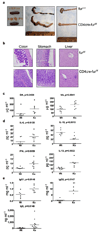T-cell-expressed proprotein convertase furin is essential for maintenance of peripheral immune tolerance
- PMID: 18701887
- PMCID: PMC2758057
- DOI: 10.1038/nature07210
T-cell-expressed proprotein convertase furin is essential for maintenance of peripheral immune tolerance
Abstract
Furin is one of seven proprotein convertase family members that promote proteolytic maturation of proproteins. It is induced in activated T cells and is reported to process a variety of substrates including the anti-inflammatory cytokine transforming growth factor (TGF)-beta1 (refs 2-4), but the non-redundant functions of furin versus other proprotein convertases in T cells are unclear. Here we show that conditional deletion of furin in T cells allowed for normal T-cell development but impaired the function of regulatory and effector T cells, which produced less TGF-beta1. Furin-deficient T regulatory (Treg) cells were less protective in a T-cell transfer colitis model and failed to induce Foxp3 in normal T cells. Additionally, furin-deficient effector cells were inherently over-active and were resistant to suppressive activity of wild-type Treg cells. Thus, our results indicate that furin is indispensable in maintaining peripheral tolerance, which is due, at least in part, to its non-redundant, essential function in regulating TGF-beta1 production. Targeting furin has emerged as a strategy in malignant and infectious disease. Our results suggest that inhibiting furin might activate immune responses, but may result in a breakdown in peripheral tolerance.
Figures




References
-
- Roebroek AJ, et al. Failure of ventral closure and axial rotation in embryos lacking the proprotein convertase Furin. Development. 1998;125:4863–4876. - PubMed
-
- Shiryaev SA, et al. Targeting host cell furin proprotein convertases as a therapeutic strategy against bacterial toxins and viral pathogens. J Biol Chem. 2007;282:20847–20853. - PubMed
-
- Taylor NA, Van De Ven WJ, Creemers JW. Curbing activation: proprotein convertases in homeostasis and pathology. Faseb J. 2003;17:1215–1227. - PubMed
Publication types
MeSH terms
Substances
Associated data
- Actions
Grants and funding
LinkOut - more resources
Full Text Sources
Other Literature Sources
Molecular Biology Databases

